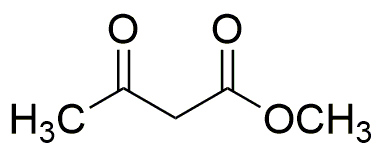Methyl acetoacetate is widely utilized in research focused on:
- Synthesis of Pharmaceuticals: This compound serves as a key intermediate in the synthesis of various drugs, including anti-inflammatory and analgesic medications, enhancing the efficiency of pharmaceutical development.
- Flavor and Fragrance Industry: Methyl acetoacetate is used to create fruity flavors and fragrances, making it popular in food and cosmetic products. Its pleasant aroma adds value to consumer goods.
- Polymer Production: It plays a significant role in the production of polymers and resins, contributing to the manufacturing of coatings and adhesives that are durable and resistant to environmental factors.
- Organic Synthesis: Researchers utilize this compound in various organic synthesis reactions, including Michael additions and Claisen condensations, allowing for the creation of complex molecules in a straightforward manner.
- Biochemical Research: Methyl acetoacetate is employed in biochemical studies to investigate metabolic pathways, particularly in studies related to ketone bodies and energy metabolism, providing insights into cellular processes.
General Information
Properties
Safety and Regulations
Applications
Methyl acetoacetate is widely utilized in research focused on:
- Synthesis of Pharmaceuticals: This compound serves as a key intermediate in the synthesis of various drugs, including anti-inflammatory and analgesic medications, enhancing the efficiency of pharmaceutical development.
- Flavor and Fragrance Industry: Methyl acetoacetate is used to create fruity flavors and fragrances, making it popular in food and cosmetic products. Its pleasant aroma adds value to consumer goods.
- Polymer Production: It plays a significant role in the production of polymers and resins, contributing to the manufacturing of coatings and adhesives that are durable and resistant to environmental factors.
- Organic Synthesis: Researchers utilize this compound in various organic synthesis reactions, including Michael additions and Claisen condensations, allowing for the creation of complex molecules in a straightforward manner.
- Biochemical Research: Methyl acetoacetate is employed in biochemical studies to investigate metabolic pathways, particularly in studies related to ketone bodies and energy metabolism, providing insights into cellular processes.
Documents
Safety Data Sheets (SDS)
The SDS provides comprehensive safety information on handling, storage, and disposal of the product.
Product Specification (PS)
The PS provides a comprehensive breakdown of the product’s properties, including chemical composition, physical state, purity, and storage requirements. It also details acceptable quality ranges and the product's intended applications.
Certificates of Analysis (COA)
Search for Certificates of Analysis (COA) by entering the products Lot Number. Lot and Batch Numbers can be found on a product’s label following the words ‘Lot’ or ‘Batch’.
*Catalog Number
*Lot Number
Certificates Of Origin (COO)
This COO confirms the country where the product was manufactured, and also details the materials and components used in it and whether it is derived from natural, synthetic, or other specific sources. This certificate may be required for customs, trade, and regulatory compliance.
*Catalog Number
*Lot Number
Safety Data Sheets (SDS)
The SDS provides comprehensive safety information on handling, storage, and disposal of the product.
DownloadProduct Specification (PS)
The PS provides a comprehensive breakdown of the product’s properties, including chemical composition, physical state, purity, and storage requirements. It also details acceptable quality ranges and the product's intended applications.
DownloadCertificates of Analysis (COA)
Search for Certificates of Analysis (COA) by entering the products Lot Number. Lot and Batch Numbers can be found on a product’s label following the words ‘Lot’ or ‘Batch’.
*Catalog Number
*Lot Number
Certificates Of Origin (COO)
This COO confirms the country where the product was manufactured, and also details the materials and components used in it and whether it is derived from natural, synthetic, or other specific sources. This certificate may be required for customs, trade, and regulatory compliance.

